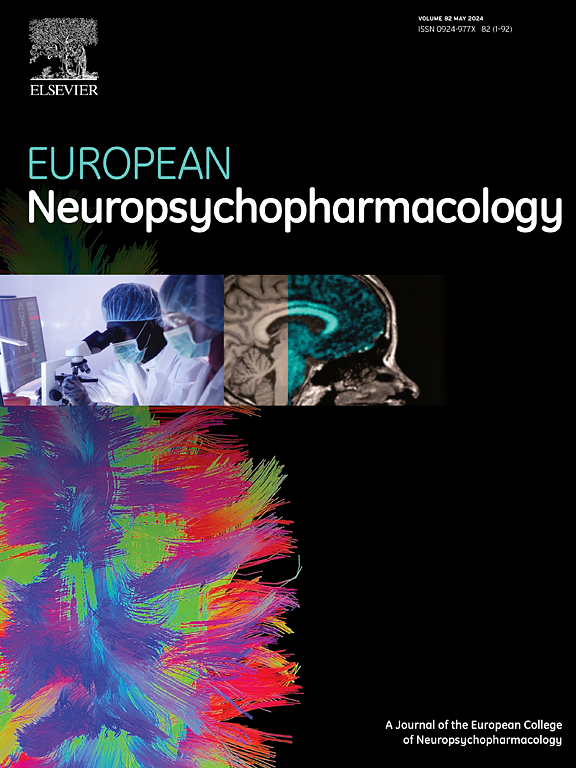Exploring the prospective association of serum interleukin-1β and brain-derived neurotrophic factor with antidepressant treatment response
IF 6.1
2区 医学
Q1 CLINICAL NEUROLOGY
引用次数: 0
Abstract
This study investigated the prospective association of serum interleukin-1 beta (sIL-1β) and brain-derived neurotrophic factor (sBDNF) with 12-week antidepressant treatment outcomes in patients with depressive disorders. We analyzed baseline levels of sIL-1β and sBDNF in 1,086 patients participating in a naturalistic, stepwise antidepressant treatment study. Remission was defined by a Hamilton Depression Rating Scale score of ≤7 at 12 weeks. Logistic regression, adjusted for sociodemographic and clinical covariates, was used to assess the relationships between biomarker levels and treatment outcomes. Higher sIL-1β levels were significantly associated with non-remission at 12 weeks in patients with lower sBDNF levels, while in patients with higher sBDNF levels, sIL-1β did not significantly impact remission outcomes. The interaction between sIL-1β and sBDNF significantly associated with remission status, even after adjusting for confounders. The study suggests the significant role of the interplay between inflammatory and neuroplastic systems in influencing antidepressant treatment outcomes. These findings underscore the potential of integrating biomarker profiles to enhance personalized antidepressant strategies, advancing treatment precision in depressive disorders. Future research should focus on elucidating the dynamic mechanisms behind these biomarker interactions to further refine models that assess treatment responsiveness and develop targeted therapeutic interventions.
探讨血清白细胞介素-1β和脑源性神经营养因子与抗抑郁治疗反应的前瞻性关联
本研究调查了抑郁症患者血清白细胞介素-1β(sIL-1β)和脑源性神经营养因子(sBDNF)与 12 周抗抑郁治疗结果的前瞻性关联。我们分析了参加自然递进式抗抑郁治疗研究的 1086 名患者的 sIL-1β 和 sBDNF 基线水平。12周时汉密尔顿抑郁量表评分≤7分即为缓解。经社会人口学和临床协变量调整后,采用逻辑回归评估生物标志物水平与治疗结果之间的关系。在sBDNF水平较低的患者中,较高的sIL-1β水平与12周后未缓解显著相关,而在sBDNF水平较高的患者中,sIL-1β对缓解结果没有显著影响。即使在调整了混杂因素后,sIL-1β和sBDNF之间的相互作用仍与缓解状态有显著相关性。这项研究表明,炎症和神经可塑性系统之间的相互作用在影响抗抑郁治疗结果方面发挥着重要作用。这些发现强调了整合生物标志物特征以加强个性化抗抑郁策略的潜力,从而推进抑郁障碍的精准治疗。未来的研究应侧重于阐明这些生物标志物相互作用背后的动态机制,以进一步完善评估治疗反应性的模型,开发有针对性的治疗干预措施。
本文章由计算机程序翻译,如有差异,请以英文原文为准。
求助全文
约1分钟内获得全文
求助全文
来源期刊

European Neuropsychopharmacology
医学-精神病学
CiteScore
10.30
自引率
5.40%
发文量
730
审稿时长
41 days
期刊介绍:
European Neuropsychopharmacology is the official publication of the European College of Neuropsychopharmacology (ECNP). In accordance with the mission of the College, the journal focuses on clinical and basic science contributions that advance our understanding of brain function and human behaviour and enable translation into improved treatments and enhanced public health impact in psychiatry. Recent years have been characterized by exciting advances in basic knowledge and available experimental techniques in neuroscience and genomics. However, clinical translation of these findings has not been as rapid. The journal aims to narrow this gap by promoting findings that are expected to have a major impact on both our understanding of the biological bases of mental disorders and the development and improvement of treatments, ideally paving the way for prevention and recovery.
 求助内容:
求助内容: 应助结果提醒方式:
应助结果提醒方式:


